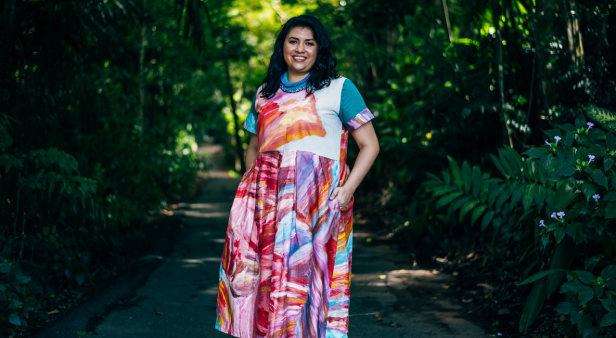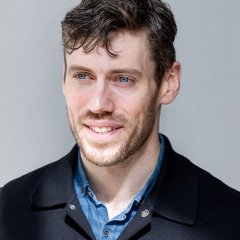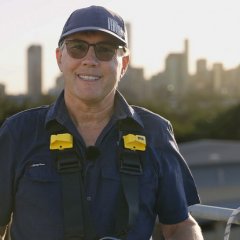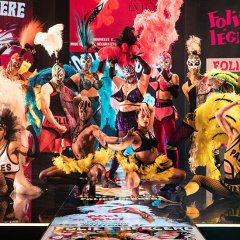You wear many creative hats – as an artist, designer and mentor, to name a few. Can you recall any formative influences or experiences that you think helped encourage or develop your artistic inclinations?
For me, it all began with exploring my own identity. First Nations Fashion and Design (FNFD) exists because we need a platform for independent designers, and at the moment there is no national platform like FNFD. I think the organisation was really founded by a gap and a real need the industry. Myself and a group of other Indigenous designers worked together to make this platform so we can celebrate who we are.
Much of your artistic practice incorporates elements of design, particularly in the areas of fashion and adornment. What drew you towards wearable art and bespoke cultural design as an area of keen interest?
It was actually in high school when I used to enter wearable art competitions. My mum is a hairdresser and my dad is an artist so I have been surrounded by Indigenous art for most of my life. It was always my main focus to win the supreme award for my wearable art and in my final year (Garde 12), I did! Through doing some Spotlight sewing courses, and using my own visual art, I painted my own fabric for the collection. My mum would often be involved with or host fashion shows, being a hairdresser, so it kind of all came together.
Your work draws a lot of inspiration from your Indigenous heritage – can you share insight into how these inspirations and techniques manifest in your work and how this approach has allowed you to explore your lineage and also connect and strengthen your personal identity?
I work closely with one of my elders Uncle Ken Thaiday, who has really mentored and supported the growth of my practice. For me, I feel like it’s an integral part of my learning, and for my healing – to understand who I am and the past that’s happened in my family. My approach and practice enables me to be proud of who I am and where I come from.
You work with several Indigenous communities and art centres to foster the act of cultural craftsmanship via a creative fashion and performance-based platform. What inspired you to engage with young people from remote communities and encourage creative expression in this way?
I think self-determination and seeing the growth in small businesses, for people like myself, is super important. Working with other Indigenous designers and people in the industry really excites me. For far too long, the industry has not had enough Indigenous representatives and I am excited to support our next generation of incredible artists and see the growth within the industry as a result.
There is a sense of preservation and celebration of culture carried through your work and mentorship roles. How do you think contemporary fashion can celebrate a culture and communicate its story and beauty compared to other artistic modalities?
I think that fashion is really exciting because it’s a different form of celebration of our culture. It’s tangible and relatable to a wide network of people that are interested on learning about the first people of Australia. I think fashion is a soft entry (what I call it) into a conversation that maybe hasn’t been had in the past, to learn about how diverse we are as first people. It’s a really beautiful way to celebrate who we are and where we come from, and to get to share that with the world.
Your latest project, First Nations Fashion: Walking in Two Worlds, is taking place as part of Brisbane Festival on Sunday September 5 – can you tell us a bit about the show, how it came together and what audiences can expect?
Well, First Nations Fashion: Walking In Two Worlds started out in Yarrabah near Cairns in Far North Queensland, and this Brisbane Festival event is a really beautiful way to continue that journey. To have a number of models from Yarrabah coming to walk on Meanjin country and be part of this continuation of work we’re aiming to achieve is very special. It’s about creating pathways for First Nations people into the industry. Audiences should expect to come to a space where they will (hopefully) be moved to learn a bit more about our culture, but also I hope we see a lot of mob at the show. I think First Nations Fashion: Walking In Two Worlds really speaks to a lot of our stories – it’s a space to dream, and a place for people to be immersed in black excellence, from the model, to the designers, to the music and performances.
Beyond the incredible artists being showcased in First Nations Fashion: Walking in Two Worlds, are there any other designers or creatives whose work you think is making a positive impact that more people should know about?
We’re really excited to have local Indigenous hip-hop artist Kaylah Truth as part of First Nations Fashion: Walking In Two Worlds, who has toured nationally and performed with acts like TLC, Lupe Fiasco, Tyson and more. It’s a real coup for the show! We’re also working with a local Indigenous videography company Wirrim Media, who will be capturing some First Nations Fashion: Walking In Two Worlds behind-the-scenes content at the Kalutha Botanical Gardens.
Finally, we’d love to know what your go-to method for recharging the batteries, both creatively and for life in general. What are some of your favourite methods of self care and inspiration gathering?
For me, it’s surrounding myself with really positive and likeminded people, and having close family and friends. I love to gather and share good food – being out on country and within nature at the same time is even better. It’s a big part of care and healing, and that’s really important for FNFD as an organisation – to create a culturally safe environment which happens organically when gathering together out on country.
You can catch First Nations Fashion: Walking in Two Worlds at part of Brisbane Festival’s 2021 program at the South Bank Piazza on Sunday September 5. Snag a ticket or two via the Brisbane Festival website!




